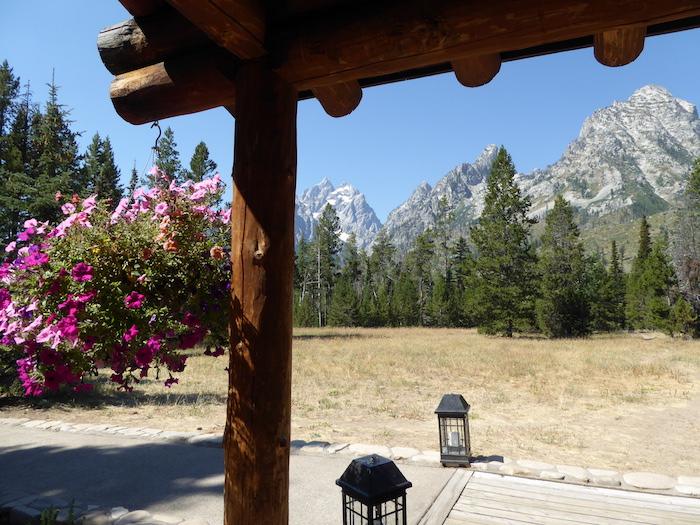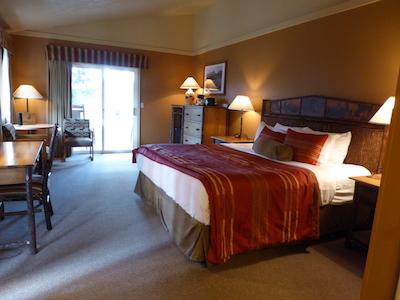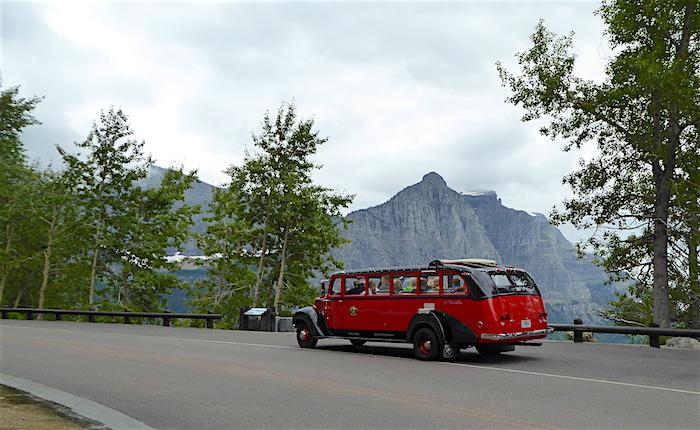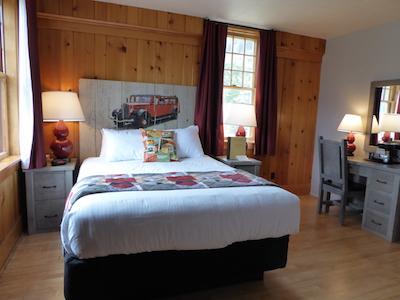
Flowers and mountains outside Jenny Lake Lodge in Grand Teton National Park/David and Kay Scott
We are nearing the end of a trip of nearly three weeks during which we stayed in or visited 24 national park lodges in Yellowstone, Grand Teton, and Glacier national parks. As a conclusion to three weeks in three of America's most popular national parks we thought it might be worthwhile to offer some thoughts about the trip, the lodges, and the people.
Our first night was at Lake Hotel in Yellowstone National Park and our last night was in Glacier Park Lodge just outside Glacier National Park. While we love the three parks, the primary purpose was to gather information for a revision of our book on national park lodges. We obviously couldn't have stayed overnight at each of the 24 lodges in three weeks, but we were able to stay in six and visit the rest.
Although the air is getting a little smoky from numerous wildfires (it is dry out here) we couldn't have asked for better weather or a friendlier group of people. Many of the park lodges seemed to be decorated with more flowers than during previous trips. The flowers' brilliant colors contrast nicely with the dark brown exteriors that characterize the majority of lodges. These added to the beauty of historic buildings that already bring a smile and sense of awe to travelers. Nowhere were the flowers more beautiful than at Glacier Park Lodge.
Crowds, Staffing, And Connectivity
We cannot remember a trip to any of the three parks when they were more crowded. A ranger at the entrance station at West Glacier commented that visitation to the park was up 16 percent over last year. We believe it. In terms of crowds, Yellowstone was the worst of the group with full parking lots, lines for dining, and lots of traffic. Fortunately, unusually dry weather appears to have caused many of the bison to head for higher elevations, resulting in fewer traffic jams along the park's crowded roads. The lobby of Old Faithful Inn was like Grand Central Station. We were told by one lodge reservation employee that bookings for next year are heavy.

Xanterra Parks & Resorts has made improvements to the accommodations at Grant Village in Yellowstone National Park/David and Kay Scott
One of the joys of staying in a national park lodge is taking time to talk with the employees. The lodges increasingly rely on foreign students for summer help. We encountered many young employees from Eastern European countries, including the Czech Republic, Slovakia, Bulgaria, Slovenia, and Poland. There were also many students from Asia, but we encountered only a few from Western Europe. The student employees are friendly and interesting to talk with. Mention that you have visited their country and their faces light up. They appeared to be excellent workers who were enjoying their experience in the parks. Most planned to engage in some end-of-the-season traveling. Not surprisingly, their primary destinations were New York City, California and, of course, the promised land of Las Vegas.
For good or evil, Wi-Fi is slowly leaching into the national park lodges. First it was cell service, now it's the Internet. Wi-Fi changes the dynamics of a stay in a national park lodge, and not necessarily in a positive way. Where in the past we have found other guests eager to engage in conversation, now many are engrossed in their iPhones, iPads, and laptops. Concessionaires seem to understand the downside, but feel an increasing number of guests expect to be connected regardless of where they are. When we visited Isle Royale National Park's Rock Harbor Lodge a couple of months ago visitors seemed quite happy even though there was no cell phone service and only sketchy Wi-Fi. Several told us they were happy to be unconnected for several days.
Expensive Stays And Changing Menus
The cost of a stay in a national park lodge has increased, sometimes dramatically. It is essentially impossible to find a room for under $100 per night, and then only if you are willing to accept a room requiring use of a community bathroom. Pioneer cabins at Yellowstone's Lake Lodge with a private bath are $88 per night, but these are the exception. The average price of a room in each of these three parks is over $200 per night. Consider that cabins in Grand Teton's Jenny Lake Lodge are now $716 per night for two persons. This includes breakfast and a gourmet dinner, but you get the point. Guest rooms at Jackson Lake Lodge are going for $300 and up. Rooms in Yellowstone's Lake Hotel begin at $380, although less expensive lodging is available in the cabins and revamped Annex that is now called Sandpiper Lodge.
Travelers visiting the parks often complain about “national park food.” There have always been exceptions, such as dining at the Inn at Furnace Creek, Jenny Lake Lodge, The Ahwahnee (or whatever it is now called), Cavallo Point, and the El Tovar, but these are the expensive exceptions. Surprising to many travelers who haven't stayed there, Pisgah Inn on the Blue Ridge Parkway has long been known for serving some excellent food options. However, most national park lodging facilities have offered food that was, at best, average.
This seems to be changing as the corporate suits and food and beverage directors seek to offer more regional selections and farm-to-table ingredients. There also seems to be a trend away from cafeteria-style dining to food courts similar to those found in shopping malls. Food choices at the parks aren't getting less expensive, but they seem to be getting better with chefs taking more pride in their offerings.

A venerable Red Jammer makes sightseeing in Glacier National Park a breeze (and breezy!)/David and Kay Scott
Glacier National Park Lodging
Xanterra Parks & Resorts, which took over the concession contract at Glacier National Park in January 2014, has undertaken major improvements in the park's lodging facilities. It was a welcome surprise when we walked into the guest rooms of Village Inn, Lake McDonald Lodge, Rising Sun Motor Inn, and the new Swiftcurrent cabins. Xanterra has spent a considerable amount of money sprucing up the Glacier lodges and it shows. Forever Resorts has also completed a number of major improvements at Signal Mountain Lodge in Grand Teton since our visit five years ago.
During our last trip to Glacier five years ago, Going-to-the-Sun Road was closed because of snow and the possibility of avalanches even though our visit was in July. Thus, it had been eight years since we drove the scenic winding road across the Montana Rockies, and we had forgotten how magnificent a drive it is. We have driven a lot of mountain roads, but none is better than the one in Glacier.

A room in the Rising Sun Lodge at Glacier National Park/David and Kay Scott
Other than nearby Isaac Walton Inn, railroad buffs can find no better facility for a stay than Glacier Park Lodge. Amtrak stops twice a day at the historic station near the front lawn, and freight trains roll through night and day. One evening we drove to nearby Marias Pass and watched a westbound Amtrak roar by. It wasn't going fast, but it was roaring.
Glacier Park Lodge welcomes from 10 to 60 guests per day who arrive in East Glacier via Amtrak. We talked with one guest from Illinois who was a member of a combination bus/Amtrak tour. The group caught Amtrak's Empire Builder in Chicago and rode to Salt Lake City where they boarded a bus for a tour of Grand Teton, Yellowstone, and Glacier. She told us many members of the tour group chose to sit in coach because they didn't want to pay extra for a cabin, which is quite expensive. The result was they arrived in Salt Lake City without much sleep following the 30-hour train trip. She said members of the tour group in the cramped sleeping compartments didn't fare much better. The trip was nearing its end when we talked with her and tour members were to catch the eastbound Amtrak the following morning. She said many in the tour group were dreading the last leg of the trip back to Chicago.
Yellowstone National Park Lodging
Lodging changes in Yellowstone's Canyon area are quite amazing. The construction of five new lodges to replace 350 aging cabins that have been removed has made Yellowstone's largest lodging facility much more attractive. Guest rooms in the new lodges are quite nice and a limited number of $140 rooms make these one of the best buys in the park. Xanterra also undertook major interior and exterior work on the six lodge buildings at Grant Village. We have always considered Grant the least desirable lodging option in Yellowstone, but with the major improvements we may have to reconsider.
So, there you have our take on a trip through three of America's crown jewels.



Comments
Thank you for an interesting report. We expect to visit Yellowstone and Grand Teton next summer, but circumstances have conspired to prevent a visit to Glacier. It is still on the to-do list.
There was a factual error in a tangential comment: "The group caught Amtrak's Empire Builder in Chicago and rode to Salt Lake City where they boarded a bus for a tour of Grand Teton, Yellowstone, and Glacier." The Empire Builder does not go to Salt Lake City. If the group went to Salt Lake City on Amtrak, it rode the California Zephyr.
We were gratifed to read the comment about Grant Village, which expressed our feelings also.
Thanks again for the article.
Really? Parks are crowded and expensive during the height of summer? What a shocker. What was the goal of this article? Seriously.
You also said, "Fortunately, unusually dry weather appears to have caused many of the bison to head for higher elevations, resulting in fewer traffic jams along the park's crowded roads."
Yes, how awful that a wildlife encounter would delay your precious trip.
You are correct, of course. They rode to SLC on the Zephyr and were riding the Empire Builder back to Chicago.
David and Kay Scott, thank you for an interesting post. I have seen the escalation of prices for prime units in our iconic parks, they are a little out of my range now. During the Yosemite Merced River Plan litigation, the park was proposing 500 new motel units at Yosemite Lodge while tearing out 500 campsites in Yosemite Valley. A young rock climber wrote a brochure, "Campsites not Hotels" which helped generate enough support to have the plan thrown out, In Yosemite, many campgrounds have been eliminated, others the sites cut back significantly. I have always felt that was a mistake, people, even of my age enjoy camping and it is still affordable. I sometimes think the wonderful hotels are now out of reach of the majority of Americans, the camping experience is not. I do not have the answers, but one young camper recently posted something like take out the hotels, replace them with campsites. I am beginning to think he is right.
The two aren't mutually exclusive.
Since the general public is made up of visitors from all income levels,
it makes sense that there is a choice among those who prefer more
comfortable lodging especially because of health issues or merely
the fatigue and mobility issues of aging. If Tim Cook, Bill Gates,
or Warren Buffett and friends were visiting, they would choose the Lodges and they would have an opportunity to experience the Beauty so emblematic of the national parks. For those watching the Fed
Financial Meetings on CNBC recently held at Jackson Lake Lodge, it was obvious that these urban dwellers, Janet Yellen, among many others were exposed to the Majesty of the Grand
Tetons and its wildlife despite the wildfire smoky periods.
These are the "high end" visitors who may be motivated to make significant contributions to the National Park Foundations.
Paul Volcker, Jr. chose Jackson Lake Lodge initially because of his
love for fly fishing !
When Crater Lake Lodge reopened in May 1995, following
complete reconstruction, former Supt.
Dave Morris made the comment to the Friends Meeting that
he would not be able to afford a room ! This of course, was
nonsense since he was probably the best compensated in
the Great Lodge Hall. Lodge Guests are always asked
during checkout if they would like to make a small contribution
to the Crater Lake Trust.
On the other side of the park visitor population spectrum
are those who arrive via the trails, like via the Pacific Crest Trail, completely by hiking ( like Thoreau with only a backpack) and
having the least impacts on the parks cleaner air and other natural resources.
Yet, no Crater Lake superintendent has been willing to welcome
Pacific Crest Trail Hikers with the comforts of a Hostel. The
Hostel idea at Redwood NP worked well until some "fat-cat"
bureaucrat decided to close it and today, RNP's Hostel remains
vacant and poorly maintained despite the local non-profit, The Redwood Park Conservancy having ample financial income to
provide support. With a more crowded world, and the desire
to provide opportunities for visitors to connect with Nature's
Beauty, the national parks need to demonstrate how humanity
and Nature can co-exist in Harmony.
Apparently, some readers of this article are just kinda grumpy. The goal of the article was to review a series of lodgings for people who do not wish to or are unable to camp in a tent or on a picnic table for whatever reason, be it physical constraints or simply that they don't want to. I much prefer a lodge over a tent, and that's my pesonal choice. Doesn't mean that I won't be camping in the future after I retire, it just means that while I can afford it, I will choose a lodge over a tent. I don't belittle those who don't wish to stay in "brick and mortar" sites. The nice thing about national parks is that they provide more than one type of lodging for everybody to use during their visit. It's not just relegated to a subset of hale and hearty hikers. And yes, I understand that lodging is getting more expensive. Lots of things are getting more expensive.
Thank you, David and Kay, for an interesting article. I haven't been to Glacier since 2009 and it's on my list of parks to which I wish to return. It's nice to see that they have done some upgrades to rooms at lodges at which I stayed back in '08-'09.
I frequently follow the Scott's articles and find them extremely informative. I particularly enjoy their details that unlock the human side of the parks.
This article resulted in an excellent discussion that I have rarely seen for a travel article.All responders brought up valid points. I just hope the powers that be of our national parks read both the article and the responses!